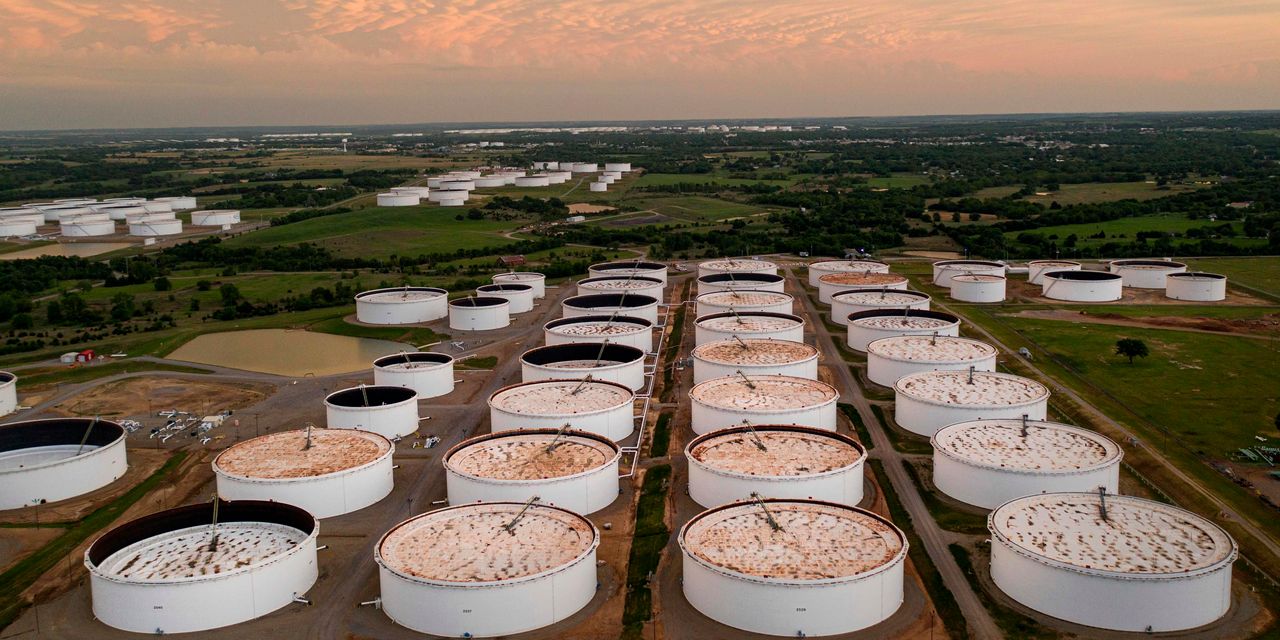Oil futures ended at their highest in more than a week on Wednesday, with prices finding support as comments from President Joe Biden fueled expectations that the U.S. will reach a deal on the debt ceiling — easing worries about the nation’s economy.
Recent economic data from China came in weaker than the market expected and the U.S. government reported Wednesday a second straight weekly rise in domestic crude stockpiles, but the International Energy Agency on Tuesday lifted its global oil demand growth forecast.
Price action
-
West Texas Intermediate crude for June delivery
CL00,
+1.03% CL.1,
+1.03% CLM23,
+1.03%
rose $1.97, or 2.8%, to settle at $72.83 a barrel on the New York Mercantile Exchange. -
July Brent crude
BRN00,
+1.13% BRNN23,
+1.13% ,
the global benchmark, added $2.05, or 2.7%, at $76.96 a barrel on ICE Futures Europe. Brent and WTI crude futures marked their highest front-month contract settlements since May 9, according to Dow Jones Market Data. -
Back on Nymex, June gasoline
RBM23,
+1.23%
rose 3.6% to $2.57 a gallon, while June heating oil
HOM23,
+0.89%
climbed 2.5% to $2.42 a gallon. -
June natural gas
NGM23,
+0.85%
declined by 0.5% to $2.37 per million British thermal units.
Market drivers
Investors are “increasingly hopeful there will be a resolution in U.S. debt talks, while forecast of a tighter oil market in the second half of the year is also helping to keep the bulls happy,” said Fawad Razaqzada, market analyst at StoneX.
In a speech at the White House Wednesday, U.S. President Joe Biden said he’s “confident that we’ll get the agreement on the budget, and America will not default.”
In response, the market saw an “uptick in risk-sensitive assets, including crude oil,” said Razaqzada, in emailed commentary.
Crude prices had declined on Tuesday after disappointment in economic data out of China. Demand concerns have plagued crude, with both WTI and Brent suffering four straight weekly declines.
Read: China’s reopening recovery is running out of steam and starting to worry financial markets
“Oil prices have been log-jammed between fundamentally oversold territory and lacking acute catalysts to shock prices materially higher over the near term,” said Michael Tran, commodity and digital intelligence strategist at RBC Capital Markets, in a note. Real-time physical indicators remain mixed, at best, he said.
“The market always expected sloppy Q1 balances, but halfway through the second quarter and the physical market is not tracking meaningfully better, yet,” he wrote. “Many market hopes hinged on China’s re-opening as being a binary market moving event, but even that framework has been mixed…and peak turnarounds are more than a month away.”
Still, the Paris-based IEA, in its monthly report released Tuesday, said China’s demand for oil is growing at a faster-than-expected pace. The growing demand threatens to tighten crude markets and send oil prices higher as supply struggles to keep up, the report said. It lifted its forecast for global oil demand growth this year by 200,000 barrels a day to 2.2 million barrels a day.
Stephen Innes, managing partner at SPI Asset Management, said he wasn’t surprised that oil prices were moving higher Wednesday after the IEA’s solid demand growth view and amid the Biden administration’s plans to repurchase up to 3 million barrels of crude oil for the SPR.
Supply data
Oil prices continued to move higher after the Energy Information Administration on Wednesday morning reported that U.S. commercial crude inventories rose by 5 million barrels for the week ended May 12.
That compared to an increase of 2.5 million barrels forecast by Robert Yawger, director of energy futures at Mizuho Securities USA, though analysts surveyed by The Wall Street Journal, on average, looked for crude inventories to show a fall of 800,000 barrels. On Tuesday, the American Petroleum Institute reported a 3.7 million barrel rise, according to a source citing the data.
The EIA report showed a weekly inventory decline of 1.4 million barrels for motor gasoline, while distillate stockpiles edged up by 100,000 barrels. Yawger had forecast weekly declines of 2 million barrels each for gasoline and distillates.
Also see: Here’s what might lead to a spike in gasoline prices this summer
Crude stocks at the Cushing, Okla., Nymex delivery hub climbed by 1.5 million barrels for the week, the EIA said, while stocks in the Strategic Petroleum Reserve fell by 2.4 million barrels.
U.S. gasoline supplied, a proxy for demand, was down by 395,000 barrels at 8.91 million barrels last week from a week earlier, but over the past four weeks, that figure averaged 9.1 million barrels, up 2.9% from the same period last year, the EIA said.
Read the full article here








